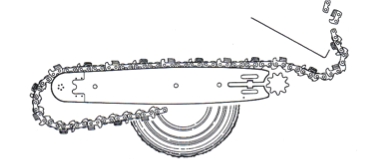
Features
Health and Safety
Sawmilling
Chain shot safety – 5 tips to reduce risk
May 26, 2017 - Don’t be complacent about chain shot safety! That’s the message of the Association of Equipment Manufacturers (AEM) as it outlines basic steps to reduce risk.
“Even very experienced operators can be exposed to the risk; manufacturers strive to design out hazards but a design that completely eliminates the chain shot hazard is a tall order,” notes Nathan Burton, a technical & safety services manager for the Association of Equipment Manufacturers (AEM).
Tree harvesters and processor attachments equipped with hydraulic bar saws cut with great power and speed, and chain breaks can cause a “crack the whip” event, explains Burton, who added that chain shot occurs usually without being noticed.
When a chain breaks, if a resulting whipping action projects a chain shot link, the link often has a mass, velocity and resultant energy, in some cases enough to reach an operator in a cab, which has potential to cause damage, harm or severe injury. This may be complicated by the remote nature of forestry operations.
AEM’s Forestry Equipment Council offers these tips to help advance chain shot safety.
1. Use correct machine settings
Know and follow recommended settings of machine and attachment manufacturer. Read operator manuals for safe operating guidance.
This includes hydraulic settings. Out of spec pressures and speed adds considerable strain, which can contribute to the risk of chain failure. Follow recommended guide bar feedload and linear speed (ft/min) recommended for the chain. Maintain the bar force according to manufacturer specifications.
2. Check every chain before and after sharpening
Always use high quality chain recommended for the attachment. Inspect each chain before mounting. Look for link pin wear, signs of strain, and accidental damage during sharpening. Discard questionable chains.
3. Avoid habits that risk chain damage
Keep the saw above ground. Remove chains at the first sign they need sharpening. Dull chains place more stress on the links.
Be sure the harvester/processor attachment is equipped with a “chain catcher” and “energy absorbing shot guard” - these greatly reduce chain shot hazards*. Inspect the shot guard and chain catcher with every visit to the attachment. Replace or repair as needed.
*The chain shot guard should meet the requirements of ISO 11837:2011 “Machinery for forestry - Saw chain shot guarding systems - Test method and performance criteria.”
4. Know and respect the “shot cone”
The likely path of shot or “shot cone” is the area of most danger as it represents the most likely route of chain shot travel. The shot cone follows the plane of the bar in both directions so all in the shot cone are at risk.
In use, orient the attachment so the “shot cone” is pointed away from you and other machine operators, co-workers, or bystanders. Check that no persons in the shot cone area are masked from your sight.
Know where the chain shot zone is relative to the bar and chain; don’t align to look directly down the bar during cuts!
5. Care for the cab windows
Cab windows that can be exposed to the “shot cone” should meet the appropriate requirements to serve as effective guards.
Don’t make unauthorized modifications to the glazing or the mount, and follow appropriate maintenance procedures. Some cleaners are not suitable for many window materials.
AEM and safety awareness
AEM supports safety awareness year-round by offering an extensive array of safety products, including operator safety manuals, for major equipment types covering forestry, aerial, agricultural, compact/portable, earthmoving, lifting, road paving and utility excavation applications.
AEM’s Forestry Equipment Council was established in 1975 as a manufacturers’ forum to discuss and work cooperatively on issues affecting forestry and forest harvest operations, including operator safety. Forestry-specific products include log skidders, tracked and wheeled fellers, tracked and wheeled harvesters, log forwarders, and knuckleboom loaders. Visit www.aem.org for more information.
May 26, 2017 By Association of Equipment Manufacturers (AEM)
 When a chain breaks
When a chain breaks Print this page